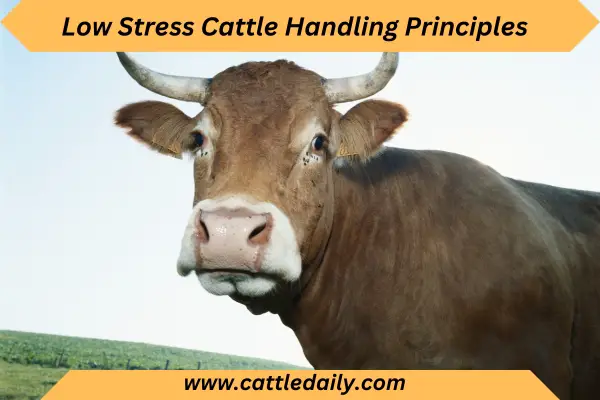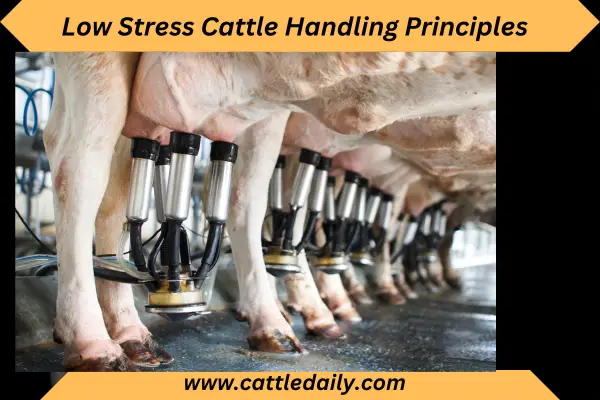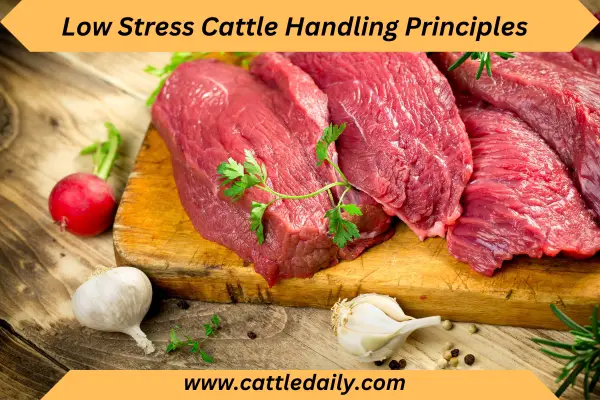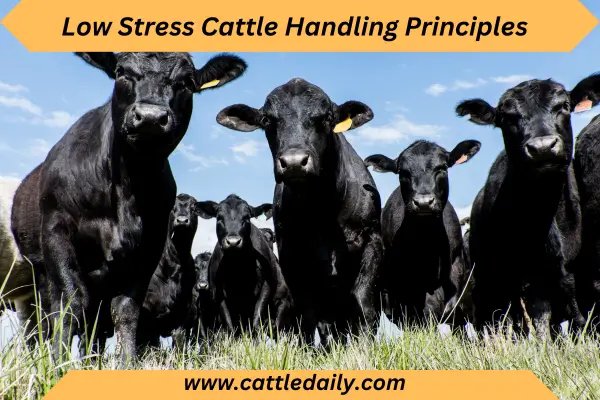Low Stress Cattle Handling Principles
Cattle handling is an important part of raising and caring for beef cattle. How cattle are handled impacts their health, welfare, and productivity.
Using low stress cattle handling techniques can benefit both handlers and cattle. In thhis article, we will discuss and cover the principles of low stress cattle handling and how to implement them on your farm or ranch.
What is Low Stress Cattle Handling?
Low stress cattle handling refers to techniques and facilities designed to move cattle calmly and gently, minimizing fear, pain, and stress. The goals of low-stress handling include:
- Improved safety for both cattle and handlers
- Reduced injuries and accidents
- Higher quality meat and milk production
- Easier processing and treatment
- Less stress on animals
By adopting low stress principles, cattle handlers can create a calmer environment that results in more docile animals. This makes tasks like veterinary care, loading cattle, and processing less difficult and safer.
Principles of Low Stress Cattle Handling
There are several core principles used in low stress cattle handling. Understanding these basics creates the foundation for building good facilities and moving cattle properly.
1. Cattle Want to See Handlers
Cattle have panoramic vision, allowing them to see almost 360 degrees. Their wide field of vision is vital to watch for predators. However, it also means that cattle want to see who is working with them.
Their flight zone, or comfort space, can extend 5-20 feet out from their shoulders. When handlers stand outside of the flight zone, cattle remain calmer.
2. Reduce Excess Noise
Loud noises easily spook cattle. Yelling or using noisy equipment adds unnecessary stress. Reduce noise from gates, pumps, and voices to keep cattle relaxed.
3. Use the Point of Balance
A beef cow’s point of balance is located at their shoulder. Light pressure applied at the point of balance can move cattle forward, while pressure behind the point of balance will stop forward movement.
Using the point of balance allows handlers to control cattle movement with minimal effort.
4. Move Calmly and Deliberately
Cattle will mirror the speed and temperament of their handlers. Moving smoothly and unhurriedly prevents cattle from becoming excited or agitated.
5. Avoid Isolation
Isolated single animals become stressed and hard to control. Cattle are herd animals that function best in groups. Design handling facilities to prevent solitary confinement.
6. Take Advantage of Natural Behavior
Understanding the natural instincts of cattle allows handlers use these inborn traits to their advantage. For example, cattle want to return to the pen they exited. Simply leaving the gate open means cattle will voluntarily walk back to their herd after processing.

Implementing Low Stress Handling
Using low stress handling starts with the facilities. Well-designed systems utilize natural cattle behaviors to improve flow and reduce balking. Once good facilities are in place, handlers should use proper techniques to move cattle calmly.
Facility Design
Good design makes moving cattle easy and prevents complications like bottlenecks. Key elements include:
- Curved alleys and tubs instead of straight lines
- Funnel shaped entry points
- Gates located on the end rather than sides of alleys
- Eliminating distractions like reflections, moving objects, or high contrasts
- Non-slip flooring
- Adequate lighting
- No sharp corners or protrusions
Solid sides block outside distractions and prevent cattle from turning back. Strategically placed catwalks allow handlers to apply pressure at the point of balance. Loading chutes should align correctly with trailers or trucks.
Proper Handling Techniques
Even in well-designed facilities, handlers must apply low stress principles to move cattle calmly. Recommended practices include:
- Use flight zone awareness to avoid crowding cattle
- Apply pressure at the point of balance with a flag or paddle to direct movement
- Move in teammates from sides to prevent backing up
- Talk or whistle in a calm steady voice
- Reduce noises that startle animals
- Walk at an easy pace and avoid rapid movements
- Never yell, whip, or prod cattle unless necessary for safety
- Allow cattle to maintain visual contact with at least one other animal
By taking the time to handle cattle patiently, tasks can be performed with less difficulty and reduced stress. Quiet handling creates a positive association with the experience, making cattle more willing to re-enter chutes and pens.

Benefits of Low Stress Cattle Handling
Implementing low stress cattle handling techniques provides numerous advantages for cattle operations of all sizes. Taking the time to move cattle calmly pays dividends through safer, more productive animals.
Here is a closer look at 10 of the top benefits of using low stress handling principles.
1. Increased Safety
Reducing stress minimizes reactive and unpredictable behavior in cattle, lowering the risks of injury to both animals and handlers. Nervous, agitated cattle are more likely to charge, kick, or jump when confined in close quarters.
This can lead to serious injury or even death. Low stress handling results in calmer and more predictable cattle that are less likely to become dangerous in processing facilities, chutes, and trailers.
With well-designed facilities with non-slip flooring prevent dangerous slips and falls that commonly cause injury. Strategic catwalks and handler access points eliminate precarious reaches over, under or through pens and chutes. Making handling systems safer for cattle also enhances safety for staff working with the animals.
2. Less Injuries and Bruising
When cattle remain calm, they are less likely to thrash, bolt or panic when restrained. Docile animals will stand relatively still, avoiding accidents that can cause bruises, lacerations, or broken bones.
Use of excessive force when handling nervous cattle often results in injuries due to falls or collisions with equipment. Low stress techniques minimize altercations, keeping cattle injury free.
Fewer injuries and less bruising also benefits meat quality. Carcasses with heavy bruising must have damaged areas trimmed away, resulting in wasted meat. Excessive use of electric prods leaves bruises, blood spots and inflammation. Eliminating rough handling protects cattle from trauma that lowers the value of beef.
3. Increased Weight Gain
Minimizing stress through low stress handling has been scientifically shown to improve average daily weight gain in feedlot cattle. A major study conducted by Texas Tech University demonstrated that calves handled gently had higher weight gain compared to those forcefully handled.
Reducing excitability and fear helps cattle conserve energy and utilize feed more efficiently for growth. When cattle are stressed, hormones are released that impede digestion and metabolic function. Low stress handling supports improved feed conversion and faster growth rates.

4. Higher Milk Production
Dairy farmers can realize significant benefits from using low stress handling methods. Studies have demonstrated that calm cattle produce higher milk yields compared to those exposed to stressful handling.
Eliminating fear and discomfort causes cows to release more oxytocin, a hormone that plays a major role in milk ejection during milking. Low stress handling may increase milk output by 8-12% or more. The quality of the milk also improves when cows remain relaxed, with higher butterfat and protein percentages.
5. Reduced Medical Costs
Cattle that remain calm and uninjured require fewer medications, antibiotics or medical treatments. Health issues like respiratory disease are closely tied to stress levels in livestock.
Lower-stress cattle have healthier immune function, making them less prone to illness. Handling related injuries are also avoided, eliminating any required veterinary care. By using low stress handling, producers save significantly on pharmaceutical and veterinary expenses.
6. Higher Reproduction Rates
Cows that cycle through the stress of rough handling techniques often have poor conception rates and reproductive performance. The hormones released during stressful events can disrupt the reproductive cycle, delay estrus and interfere with normal reproductive function.
In contrast, keeping cattle calm during handling supports higher conception rates. Low stress methods ensure optimal reproductive function and fertility.
7. Improved Meat Quality
Excessive stress right before slaughter has been shown to have negative effects on meat quality in cattle. Agitation and discomfort triggers the release of hormones that influence the pH decline in meat during the conversion of muscle to meat.
More gentle handling maintains low stress levels, safeguarding beef quality. Using low stress techniques leads directly to superior meat quality, with desirable color, enhanced tenderness and longer shelf life.

8. Fewer Staff Injuries
Making handling facilities safer for cattle also benefits farm staff. Well-designed systems allow handlers to apply pressure and move animals without entering the flight zone or closely approaching the head or heels.
This reduces the risk of being kicked, trampled, or pinned between animals and equipment. Installing catwalks and strategically placed gates allows tasks to be performed without putting personnel in harm’s way. Handling docile, calm cattle is inherently safer for workers.
9. Lower Labor Costs
Facilities designed based on low stress cattle handling principles allow tasks to be performed more efficiently. Loading chutes aligned correctly with trailers, smoothly curving alleys and wide gates located for optimal animal flow require less manpower for processing or loading.
When cattle remain calm, fewer handlers are needed to complete tasks. Well-trained staff can move docile cattle using low stress methods that streamline required chores. The reduced labor needs lower payroll costs.
10. Less Employee Turnover
Low stress cattle handling provides a safer, lower frustration work environment. When improper handling causes cattle to become agitated, work rapidly escalates from difficult to dangerous.
However, gentle handling minimizes stress, creating a calmer situation for staff. Employees experience less burnout and work-related injuries. Handling docile animals improves job satisfaction, reducing employee turnover.
Knowledge of proper low stress techniques enhances worker confidence and morale. The ability to move cattle with ease and efficiency is incredibly empowering. Ranchers reap benefits of more experienced staff who remain in positions longer.
Conclusion:
Implementing low stress cattle handling clearly provides significant benefits ranging from direct impacts on animal health and performance to lowering input costs and improving working conditions. While facilities should be designed using low stress principles, human interaction with cattle is equally important.
With proper training and commitment to animal welfare, producers can adopt techniques that enable safe, efficient, and calm handling of livestock.
When cattle and handlers work together in a low stress environment, the benefits are mutually beneficial. Learn and check here more about cattle behaviour tips and guides.


